LEGO figures in Scale models
This article shows you how I calculated the “scale” for various LEGO figures as they compare to the size of real-live humans. (This revisits a topic I first explored in 2013 with the blog post calculating minifig scale. That older article now points to this page, as this article is more accurate and covers additional figure types.)
Based on my calculations, here is the approximate scaling factor for each common LEGO figure (from largest to smallest). The calculations used to achieve these values are included below…
- Miniland – 1:17
- Minidoll (Friends) – 1:38
- Classic Minifigure – 1:42
- Microfig – 1:80
- Trophy fig – 1:130
- Three-plate fig – 1:150
It is impractical to include figures in your models at a scale smaller than about 1:125.
LEGO Units
The smallest common dimension in the LEGO System is the thickness of a LEGO brick’s wall. I call this unit 1 plastic, or simply “1 p”. (1 p = 1.6 mm, or 0.063 inches)
1 plastic is 1/2 of the height of a LEGO plate (excluding studs), 1/5 of the width of a 1x LEGO brick, or 1/6 the height of a LEGO brick (excluding studs).
Almost every measurement in LEGO elements is a whole multiple of 1 p. An exception is the thickness of a hollow stud, which is only 1/2 p.
Size of an “Average” human?
The average height of adults varies considerably with country and gender.A good approximation of the average height across both genders for the affluent regions where LEGO is popular is 170 centimeters (5’7″ / 67 inches).
For reference, average male height in Europe / United States is about 175 centimeters (5’9″ / 69 inches) and average female height is about 165 centimeters (5’5″ or 65 inches). (Source: Wikipedia.)
LEGO Minifigure
LEGO Minifigures debuted in 1978 with the “City“, “Castle” and “Space” product lines.
Unfortunately for LEGO model builders, the proportions of the classic LEGO Minifigure are wildly inaccurate as compared to a human. As such, we need to calculate the scaling factor separately based on width versus height.
LEGO Minifigure (based on height)
The classic LEGO minifigure is 4 bricks tall. If you include the stud on the top of a Minifigure’s head, it is 4 cm tall. (25 p)
25 p * 1.6 mm/p = 40 mm (4 cm)
180/4 = 45175/4 = 43.75 [average male]170/4 = 42.5165/4 = 41.25 [average female]160/4 = 40
I have rounded down slightly and concluded that 1:42 is an good estimate for the scale of LEGO Minifigures based on their height. (Rounding down also accounts for the slight increase in height when you add hair or a hat.)
NOTES:
The stud on the top of a Minifigure is ever so slightly taller than the stud on the top of a standard LEGO element. I do not know why, and did not include this subtle discrepancy in my calculations.
Adult LEGO figures are almost always the same height regardless of gender, with the exception of figures wearing a dress which are 1 plate taller than the classic figure. This is due to the fact that LEGO legs are 5 plates tall, but the 2x2x2 slope used as a dress is 6 plates tall.
LEGO Minifigure (based on width)
Since the proportions of the LEGO Minifigure as so strange, we get a radically different result if we try to calculate the scaling factor based on the minifigure’s width. This is why the scaling factor is different vertically than horizontally. (A minifigure torso is the same width and depth as a 1×2 LEGO brick, or a 2:1 ratio. Thankfully, humans have about the same 2:1 ratio.)
I measured my width at the hips as 40cm (16 inches) which is the value I used in the calculations below. (There isn’t as much data available about average width at the torso or hips as height, but a cursory scan of some sources suggest 40cm is pretty typical across both genders)
10 pl * 1.6mm/pl = 1.6 cm
40 cm / 1.6 cm = 25
Based on the LEGO minifigure’s width, we get a scale of about 1:25.
It would be easy to modify the height of a LEGO Minifigure to be proportionate to it’s width. This would result in a consistent 1:25 ratio both vertically and horizontally.
LEGO Minidoll
LEGO Minidolls were introduced in the “Friends” product line, and has expanded to include “Disney Princess” and most recently “Elves“. A LEGO minidoll is 4.5 bricks tall. If you include the stud on the top of a Minifigure’s head, it’s 4 2/3 bricks (28 p tall).
28 p * 1.6 mm/p = 44.8 mm (4.48 cm)
180/4.48 = 40.18175/4.48 = 39.06 [average male]170/4.48 = 37.94165/4.48 = 36.83 [average female]160/4.48 = 35.71
This is how I calculated an approximate scale of 1:38 for LEGO Minidolls.
When factoring in the fact that most Disney/Friends sets feature women or teens, rounding down further to 1:35 might be more accurate in some scenarios.
LEGO Miniland
64 p * 1.6 mm/p = 102 mm (10.2 cm)
170 cm / 10.2 cm = 16.67
My calculations show a scale of about 1:17 for Miniland figures..
LEGO Microfig
A LEGO microfig is 1 brick wide and 2 bricks tall. If you include the stud on the top of a Minifigure’s head, it’s 13 p tall.
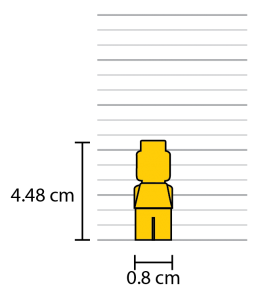
Width and Height of LEGO Microfig. (Note: Height in image is incorrect. It should say 2.08 cm tall.)
13 pl * 1.6 mm/pl = 20.8 mm (2.08 cm)
170 cm / 2.08 cm = 81
This is how I calculated a scale of 1:80 for the LEGO Microfig Since microfigs are such crude representations of people, and liek the classic Minifigure they are too wide for their height, you could reasonably use them to represen a range of scales from about 1:60 to 1:100.
LEGO Trophy fig
LEGO Trophy figs began with the Collectible Minifigure line, but you will also find them in other sets, including all three sets in the new LEGO Architecture Skyline series. A LEGO trophy is 1 brick wide and about 5 plates tall, but the figure is much smaller than that. I went with an approximation of 3 p wide and 8 p tall.
8 pl * 1.6 mm/pl = 12.8 mm (1.28 cm)
170 cm / 1.28 cm = 132
I rounded to 1:130 for the LEGO Trophy Fig.
It’s incredibly challenging to estimate their precise given the large round base, and the figure design is based on the classic Minifigure which has inaccurate proportions. It would be easy to use them in a range of scales from 1:100 to 1:150.
Three-plate fig
You can make a very crude approximation of a figure using three round 1×1 plates. Choose different colors to represent different people and clothing.
7 pl * 1.6 mm/pl = 11.2 mm (1.12 cm)
170 cm / 1.12 cm = 151.79
Based on the height of a stack of three plates, we are looking at a scale of around 1:150. If you increase the figure height to four plates, you get a scale of 1:120 which is about the same as the Trophy fig. (The width to height ratio of three-plate figs is wildly inaccurate, so you won’t be able to fit nearly as many three-plate figs in your scene than actual people.)
It’s incredibly challenging to estimate their precise given the large round base, and the figure design is based on the classic Minifigure which has inaccurate proportions. It would be easy to use them in a range of scales from 1:100 to 1:150.


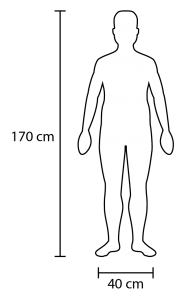
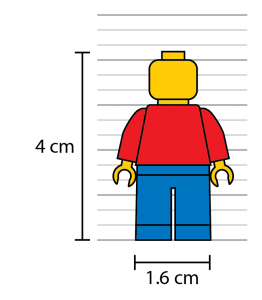
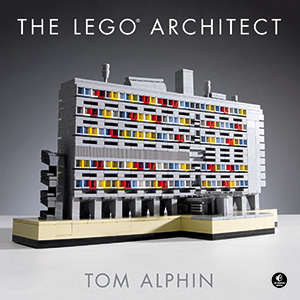

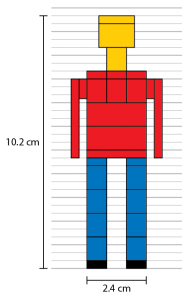

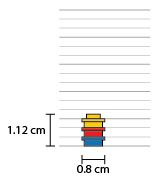
I’m looking at using building block kits from LOZ or ENJBRICK and or Lego for some of the realistic details I’m unable to find elsewhere however before I buy these kits, is there a way to know what scale they are?? I’m NOT interested in the people figures, only the buildings and I’m looking for 1.64 scale to got along with the S scale and other Plasticville models I already have. Any help or advice PLEASE!! Thank you in advance!
Erick,
The LOZ bricks are not the focus of this article, but you can learn more about them in this article: https://brickarchitect.com/2020/review-unity-temple-the-atom-brick/
The “LEGO Microfig” cant be right height!
In the picture its the same as the “LEGO Minidoll”
Stefan,
You are absolutely right – the correct value is in the math below the image: 2.08cm
I do not know where the source files for these images have gone, so I updated the caption with the correct height. Thank you for taking the time to point out this error!
Sincerely,
—Tom Alphin
So if I wanted to build a dragon in minifig-scale, which would in reality be 16 metres long, how many studs would my Lego dragon need to be in length?
Divide 16 meters by 42 to get the length in minifigure scale.
It should be about 38cm. (1600 cm / 42= 38.1cm)
What about Hot Wheels 1/64 scale? how can I convert builds?
I’m not sure I understand your question – do you want to build a LEGO city at the same scale as 1:64 scale of Hot Wheels cars? You can definitely do that, but Minifigures will be way too large for your “Hot Wheels-scale” city.
Hi, have you seen the new Avatar minifigs? Would you consider adding them to the list? They have better proportions
Maybe, this is a good idea for a future update.
What about the scale you would use for the Lego Action Figures from the mid 80s?
Are you referring to the “Galidor” product (late 90’s) or the “Technic Figure”? Either way, I had not been planning to add them to the article but it’s worth considering it – if there are other folks who want to see the article expanded, I’ll probably do it .
What about the new Avatar minifigs? Could you make an update estimating their scale please? They seem to have better proportions.
This is an interesting idea. That said, the longer legs of the Avatar figures are being used to make those characters look taller than humans, since the Avatar people are taller than humans are. If we were to see the Avatar legs in standard colors (for human figures) – you are right, the proportions would be more realistic, and the scale would be on the larger end of the spectrum. (Though you would still need to content with torso and arms being far too short.
I would like to design a house using Lego and I’m trying to figure out a good scale (it does not need to be perfectly accurate). Reading this article clearly a minifig is proportionately wider than a human, could that be fixed by adding one or two 1×1 plates onto the minifig’s feet? Then once we have the minifigs proportions somewhat corrected, and assuming the minifig is equal to 6 feet tall (for easy math), could we say that 4 bricks and 2 plates are “6 feet tall”? And 3 studs wide is “2 feet wide”? Do you think that is a good scale?
Adam,
You could certainly “correct” the LEGO minifigure by lengthening their feet or torso, but you would need to add more than a couple plates to their feet to get it right. I have done the math in the past but do not have it handy now, but I think you need to add 4 or 5 plates to get the height right based on the width, but then the arms start to look ridiculous.
As an alternative, look into the long since retired Technic figures – they are larger than a minifigure but more proportional – closer to the miniland scale in the article.
—Tom
Amazing resource, best breakdown I found of the scales so far. The only comment I would have is regarding trophyfig/nanofig scale. I feel that given the proportions of a regular lego figure vs a human, it makes a bit of sense to include the plate base of the figure if you’re trying to scale to real world items, since that gets us a little bit closer to human proportions. With that base it gets us to around 106.25 scale, so around 110:1 scale rounded. This is in line with the excellent Saturn V set from the ideas line.
I think going with the base or just figure portion would be completely personal preference, and anything ranging from 100:1 up to 140:1 could look about right with the nanofigs.
Once again, thank you so much for the great resource.
Andre,
I encourage you to use these scale calculations as just a starting point for your own modelbuilding – the estimates you suggested seem perfectly reasonable given the latitude for interpretation which is inevitable when working with these tiny scales. Ultimately, if the proportions look good in the finished model, you have succeeded .
—Tom
Good article. One quibble and one addition:
When I plug 6’7″ and 1:25 scale into Sariel’s calculator, I get a height of 7 bricks. I’m not sure I’d characterize adding 3 bricks of height to our 4-brick-tall minifigs as an “easy” modification, assuming you still want to use minifig parts as the core of this modified person. I guess you could add a 1×1 brick under each foot, a 1×2 brick at the waist, and a 1×1 round brick for a neck, but I’m not convinced that those proportions would really be any better than what we already have, and the arms would be comically short.
And here’s your data for the Technic figures, which I suspected was significantly different from “miniland scale”, so I dug one out to measure:
Height: 89.8 mm (including nonremovable hair, not including any helmet), or just a smidge over 28 plates tall, but enough less than 28.5 plates that if you stand one in a 28.5 plate-high gap, it looks like there’s a half-plate gap above their head.
Torso is 15.8mm x 10.8mm at the waist, getting slimmer and wider at the shoulders.
The entire fig is 31.2mm wide at the widest point, which is the elbows when they’re at its sides. (The shoulder joints are set a little bit closer in, making the shoulders not quite as wide.)
Feet are two studs long (16mm), and head is about 17.3mm from chin to top, 12.3mm wide, and 14.4mm wide with the ears.
So, short answer: closer in scale to Miniland than I thought: Roughly 9 bricks tall, instead of roughly 11.
Anyway, using your average of 170 cm for an adult, we get 170/8.98=18.9, or roughly 1:19 scale. If we assume that technic figs represent a 6′-tall person, we’re almost exactly at 1:20 scale.
Using your waist-width approximation, we get basically the same as with minifigs, because their waists are basically the same: 1:25.3. But this isn’t nearly as far off, because the proportions of a technic fig are a lot closer to plausible.
So I’d be inclined to go with 1:20 as “technic scale”, because the math will be less annoying than 1:19.
Oh, I forgot to say:
1:20 scale also means that a stud is roughly 6″, or exactly 16 cm (the latter of which is probably not a terribly useful correlation). Shift to 1:19 scale, and a stud becomes almost exactly 6″ (5.984″). So maybe 1:19 actually is the easier scale to do the math for.
Using a Lego “stud” space, 8 mm, to represent 1 foot (304.8 mm) results in a scale of 1:38 as well. ( 304.8 ÷ 8 = 38.1 )
This is a great reference for Lego scale. Railway models from Lego offer another way to derive a scale of ~1:38. Lego trains (https://en.wikipedia.org/wiki/Lego_Trains) use a track with a 37.5mm gauge (distance between the inside edges of the rails) and a USA standard gauge railroad prototype (real world tracks) has a gauge of 1435 mm (4 feet 8½ inches). 1435 ÷ 37.5 = 38.27 . Rounding down just a bit for convenience leads to 1:38 scale.
I’ve only just started modelling buildings for fun with lego, but I’ve taken a rather different approach. It seems to me that basing the architecture scale on the figures doesn’t make much sense – the scale should be based on the building components you are trying to model since there will be far more that in your model than figures. You could easily create cardboard cutouts to represent people in your model at whatever scale you like.
If you are looking to model say a house – including interior, then you really need to be able to do a lot of walls. If you go at minifigure scale, this doesn’t work as the 1×1 brick is any where from 12 to 14″ square, and a wall is typically 5″ wide. Since a wall is 5″ wide, and a 1×1 brick is 5p, it might make good sense to simply do a 1p = 1″ scale. So a 1×1 brick is 5″ per side and 6″ high (not counting the stud). This scale works nicely for 30″ x 7′ doorways as well.
What about Star Wars buildable figures ?
That’s a good idea, but I’m afraid that I do not have the figures and don’t have time to do the research right now. If you make some measurements of approximate height, width and depth of a typical figure (ex: Storm Trooper), we can calculate the scale.
Based on the Minidoll scale, each 1×1 stud/plate/brick area is about 1 square foot. That seems like a convenient way to translate US buildings to Lego scale.
Another option is to consider the Head. It’s 1 brick high, or 3/8 in. A human head is about 1 ft from top to shoulder, so a scale of 1;32. This makes a mini fig 4 ft tall, (child size) but makes doors only 5 ft tall. need to add 2 bricks to a mini fig and 2 bricks to a door.
What about big figs?
Ex: hulk, thanos, killer croc, etc
Big figs should be the same scale as minifigs because they appear in the same sets as minifigs. That said, I have no idea how carefully that LEGO designers have worked to ensure that bigfigs are correctly scaled to their minifig counterparts.
(Besides, they are fictional, and scale model building in the real world is the focus of this article .)
I’ve used a different approach to deciding on minifigure scale: deciding that an average door opening is 90cm, corresponding to 4 studs. That gives a scale of 1:28, which fits nicely between the width and length scales for a minifig. Only downside is that building to 1:28 will make the minifigs rather short for their environment.
Btw, I got the Lego Architect book for my birthday. Lovely!
What about LEGO Technic Action figures ?
I have considered adding it to the article, but haven’t had a chance. I think they are about the same scale as a miniland figure.
Albeit their heads are more disproportionate, having looked at the few I still own…
The lego man is not too wide. It’s too short. The width of the plates and bricks is based on his width. That means that if we make the Lego man taller, the problem would be solved. I realized that we should add two 1×1 plates to each of his feet. The Lego factory should rebuild the lego man so he have longer legs. The additional length equals two 1×1 plates on each foot which is 6,4 mm in length/height for each leg.